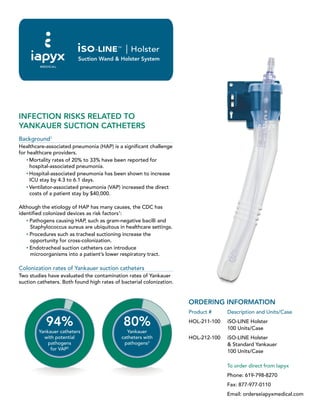iapyx Iso line Yankauer Holster
- 1. INFECTION RISKS RELATED TO YANKAUER SUCTION CATHETERS Background1 Healthcare-associated pneumonia (HAP) is a significant challenge for healthcare providers. ŌĆó Mortality rates of 20% to 33% have been reported for hospital-associated pneumonia. ŌĆó Hospital-associated pneumonia has been shown to increase ICU stay by 4.3 to 6.1 days. ŌĆó Ventilator-associated pneumonia (VAP) increased the direct costs of a patient stay by $40,000. Although the etiology of HAP has many causes, the CDC has identified colonized devices as risk factors1 : ŌĆó Pathogens causing HAP, such as gram-negative bacilli and Staphylococcus aureus are ubiquitous in healthcare settings. ŌĆó Procedures such as tracheal suctioning increase the opportunity for cross-colonization. ŌĆó Endotracheal suction catheters can introduce microorganisms into a patientŌĆÖs lower respiratory tract. Colonization rates of Yankauer suction catheters Two studies have evaluated the contamination rates of Yankauer suction catheters. Both found high rates of bacterial colonization. ORDERING INFORMATION Product # Description and Units/Case HOL-211-100 iSO-LINE Holster 100 Units/Case HOL-212-100 iSO-LINE Holster & Standard Yankauer 100 Units/Case 94% 80% Yankauer catheters with potential pathogens for VAP2 Yankauer catheters with pathogens3
- 2. References: 1. Tablan OC, et al. Guidelines for preventing health-care-associated pneumonia, 2003: recommendations of the CDC and the Healthcare Infection Control Practices Advisory Committee. MMWR Recomm Rep. 2004;53(RR-3):1-36. 2. Sole ML, et al. Bacterial growth in secretions and on suctioning equipment of orally intubated patients: a pilot study. Am J Crit Care. 2002;11(2):141-149. 3. Brown M, et al. Colonization of Yankauer suction catheters with pathogenic organisms. Am J Infect Control. 2005;33(8):483-485. SOLE 2002: Gram-positive bacteria ŌĆóStaphylococcus aureus (not drug resistant) ŌĆóS aureus (methicillin resistant) ŌĆóStreptococcus Gram-negative bacteria ŌĆóKlebsiella ŌĆóAcinetobacter ŌĆóPseudomonas ŌĆóProteus ŌĆóEscherichia coli ŌĆóEnterobacter Yeast BROWN 2005: ŌĆóCandida series ŌĆóEnteric gram-negative rods ŌĆóStaphylococcus (coagulese-negative) ŌĆóMRSA ŌĆóStaphylococcus (methicillin-resistant) ŌĆóViridans streptococci ŌĆóEnterococcus (vancomycin-sensitive) ŌĆóVRE Bacteria present in Yankauer suction catheters included MRSA and VRE Pathogens identified across studies included both MRSA and VRE On a shelf Yankauer suction catheters were commonly stored on shelves, hanging freely, and on patient beds2,3 70% 60% 50% 40% 30% 20% 10% 0% Designated holder Equipment top Hanging freely Patient bed Floor 66% 55% 30% 21% 5% 13% 10%


